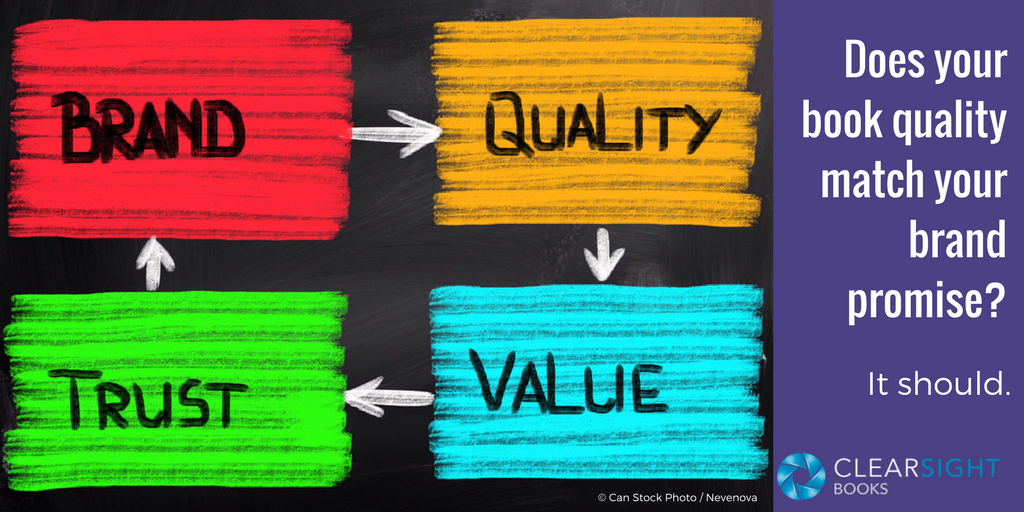 When writing a book as part of your business growth strategy, your business will be judged on the quality of your book. As a result, your book quality should match your brand promise.
When writing a book as part of your business growth strategy, your business will be judged on the quality of your book. As a result, your book quality should match your brand promise.
Consider: When you shop for clothes, you likely visit different stores for different pieces. You go to the store whose brand, quality, and value you trust to match your needs:
- Walmart – Everyday low prices. (Underwear is underwear, man.)
- Target – Slightly higher prices, but much better design. (Ooh, cute sundress.)
- Macy’s – Good quality, almost always on sale. (Standard work clothes, here I come.)
- Nordstrom – Designer goods with service and prices to match. (Dress shoes? Yes, please!)
Just as shoppers need a spectrum of shopping options, there are strategic reasons to target different audiences with different levels of book quality.
Book Quality Criteria
In a recent article, I wrote about four categories of book quality criteria I use:
- Content – The freshness of ideas presented, the insight shown, the supporting evidence provided.
- Structure – The clarity of organization, the logic and context, how well the reader is led through the book.
- Craft – The strength of the writing itself: correct mechanics, smooth style, engaging voice.
- Format – The professionalism of cover and interior, the alignment with publishing standards, the sophistication of design.
Setting aside unacceptable quality (typos, lack of editing, poor design), let’s look at quality considerations for three [imaginary] businesses [based on real conversations].
Brand Promise 1: Quick and Simple
Clara’s business helps solopreneurs and small businesses create videos. She makes studio space and equipment accessible and affordable for DIY projects and offers straightforward production services. “Quick and simple” is her motto.
Clara’s book targets less-experienced DIYers. Her book quality strategy:
- Content – Clara is writing a basic how-to book, so her ideas aren’t especially fresh, but that’s OK; beginners need the ABCs.
- Structure – Clarity is critical for beginners and DIYers. Clara makes things simple and straightforward with clear headings and step-by-step processes.
- Craft – Since the content itself won’t be particularly novel, Clara inserts a strong “casual and fun” voice to match her “quick and simple” brand promise.
- Format – For “quick and simple” Clara also wants “short and fast-moving.” This implies a design with larger, more casual fonts, plenty of white space, and images to demonstrate her points.
Clara’s easy-to-read, basic-quality how-to book matches her brand promise of “quick and simple.”
Brand Promise 2: Solid, Professional, and Modern
Kirby offers HR consulting services for a middle-market business audience. His brand is solid and professional, though modern in its approach.
Kirby’s book targets Millennials who are growing into mid-management leadership roles. His book quality strategy:
- Content – Kirby’s content covers the basics, then takes them further. While many of the ideas are not brand new, they do reflect his unique perspective as a borderline Gen Xer/Millennial; he speaks both languages and translates intergenerational lingo and attitudes effectively.
- Structure – For his professional audience, Kirby uses more structural complexity than Clara does in her how-to book. He also adds sidebars and Tweet-size quotes to offer quick takeaways.
- Craft – Kirby’s style also is more complex and sophisticated than Clara’s, though that doesn’t mean difficult to read. His voice is contemporary but still professional.
- Format – To match “solid, professional, and modern,” Kirby uses relatively standard fonts and formatting, with distinctly modern design elements.
All in all, Kirby’s Millennial management book matches his professional, modern brand, without going to any extremes.
Brand Promise 3: High-End Prestige
Vanessa is an executive coach for C-suite professionals at Fortune 1000 companies. She has a high-end, prestige brand.
Her leadership book delves into the subtle yet pervasive mental models that executives tend to trap themselves in. Her book quality strategy:
- Content – Vanessa’s ideas feel fresh and offer significant insight. Her book uses case studies liberally to help executives see themselves reflected.
- Structure – Vanessa knows executives are pressed for time, so while her book contains complex ideas, the structure remains clear and chunked into segments that can be read in short bursts.
- Craft – Vanessa’s writing shows sophistication, but “high-end prestige” doesn’t mean “stuffy.” It means her style and voice connect quickly and directly with readers; it demonstrates she knows and understands their experience.
- Format – To match “high-end prestige,” Vanessa wants her book to be a pleasure to hold and read. She has a sophisticated book design with classic fonts and custom graphic elements, and she’s printing hardback as well as paperback.
Vanessa’s high book quality matches the prestige brand promise she makes consistently in her executive-coaching business.
Each author delivers the quality needed by his or her respective audience. Consider how it would feel if you were to swap the quality of Clara’s and Vanessa’s books. Like a too-big hand-me-down garment, neither book would fit the intended audience.
Before beginning your book, go back to your business strategy:
- Who is your ideal client (or target market, or intended audience)?
- What is your current brand promise to them?
- How do you maintain that promise in book form?
If you’re struggling to develop a strong strategy, a book coach can often help. If you think you and I might be a fit to work together (see what I did there?), please get in touch for a complimentary conversation.

